PDQ Yachts in Whitby, Ontario, Canada, launched the Alan Slater-designed PDQ 32 catamaran in 1994 and built 53 of the boats in the following eight years. The PDQ 32 has proven to be a high-quality boat—bashing through rough seas without a groan—with bulletproof basics. It remains pretty darn quick (PDQ), outpacing much larger boats, and most PDQ 32s today sell for what they cost 15 to 20 years ago ($85,000 to $110,000).
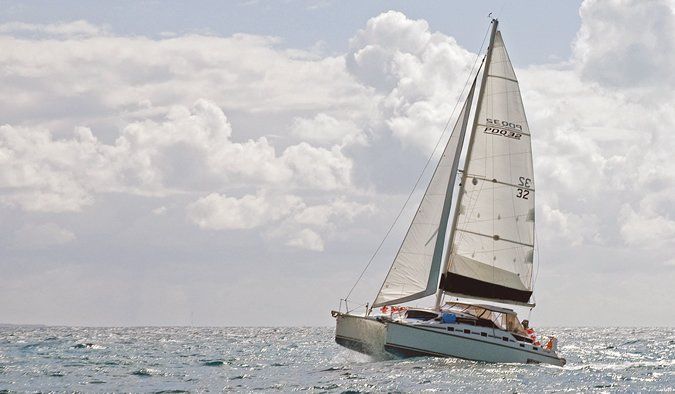
Photo by James Forsyth
THE DESIGN
The PDQ 32 was kept lightweight—7,200-pound displacement—through efficient design and the smart use of triaxial cloth, acrylic modified epoxy resin (AME 5000), Klegecell core, and even carbon fiber (in the main beam). As a general rule, fast cats have displacement-to-length (D/L) ratios between 50 and 70, and slow cruisers about 100 to 120. With a D/L ratio of 108, the PDQ 32 could be on the slow side, but the D/L doesn’t tell the entire story.
Its sail area-to-displacement (SA/D) ratio of 19 indicates ample power to drive the hulls; the SA/D increases to 23 with the addition of a genoa. The beam-to-length ratio is 0.52, meaning length overall is nearly twice the beam. While some catamarans, such as the Lagoon 37 (0.60 beam to length ratio) come in much higher, this is a compromise. Ratios greater than 0.5 can lead to bow-burying and increased dockage rates.
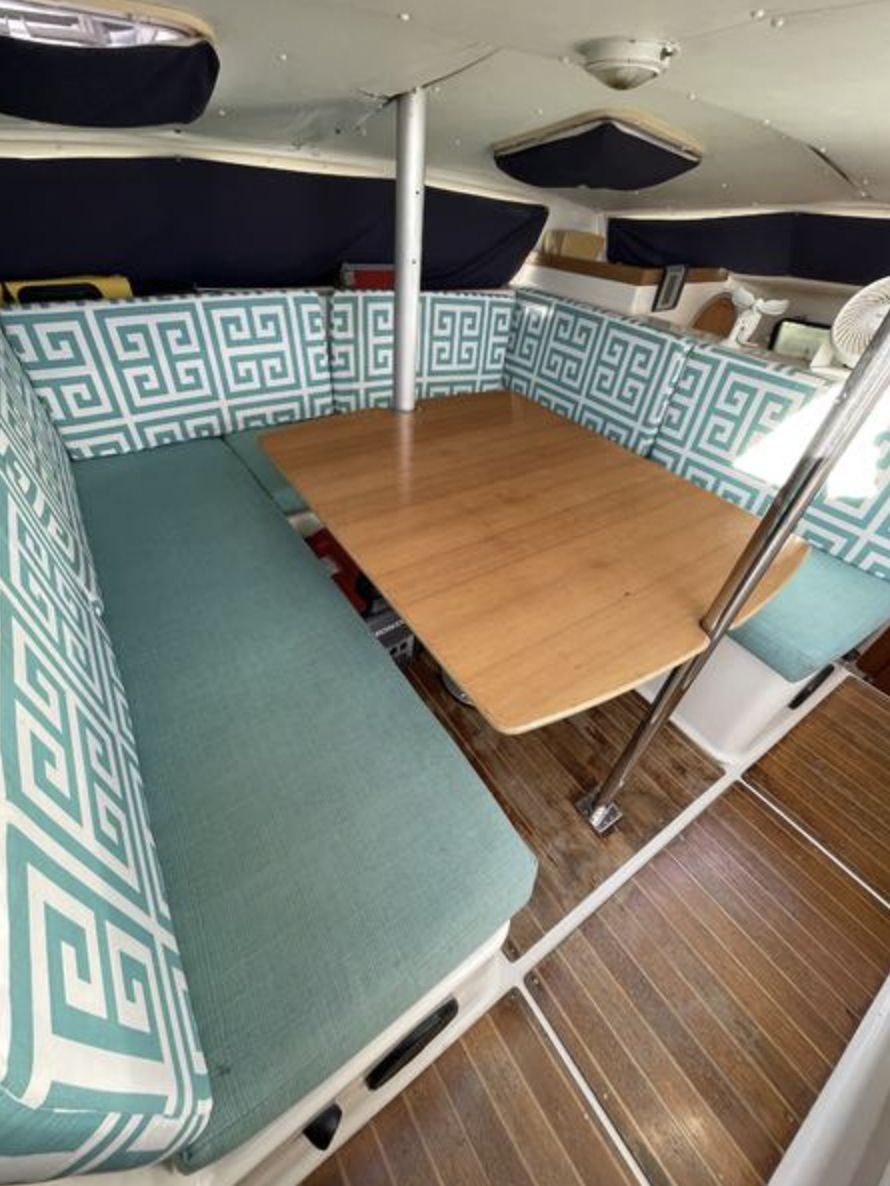
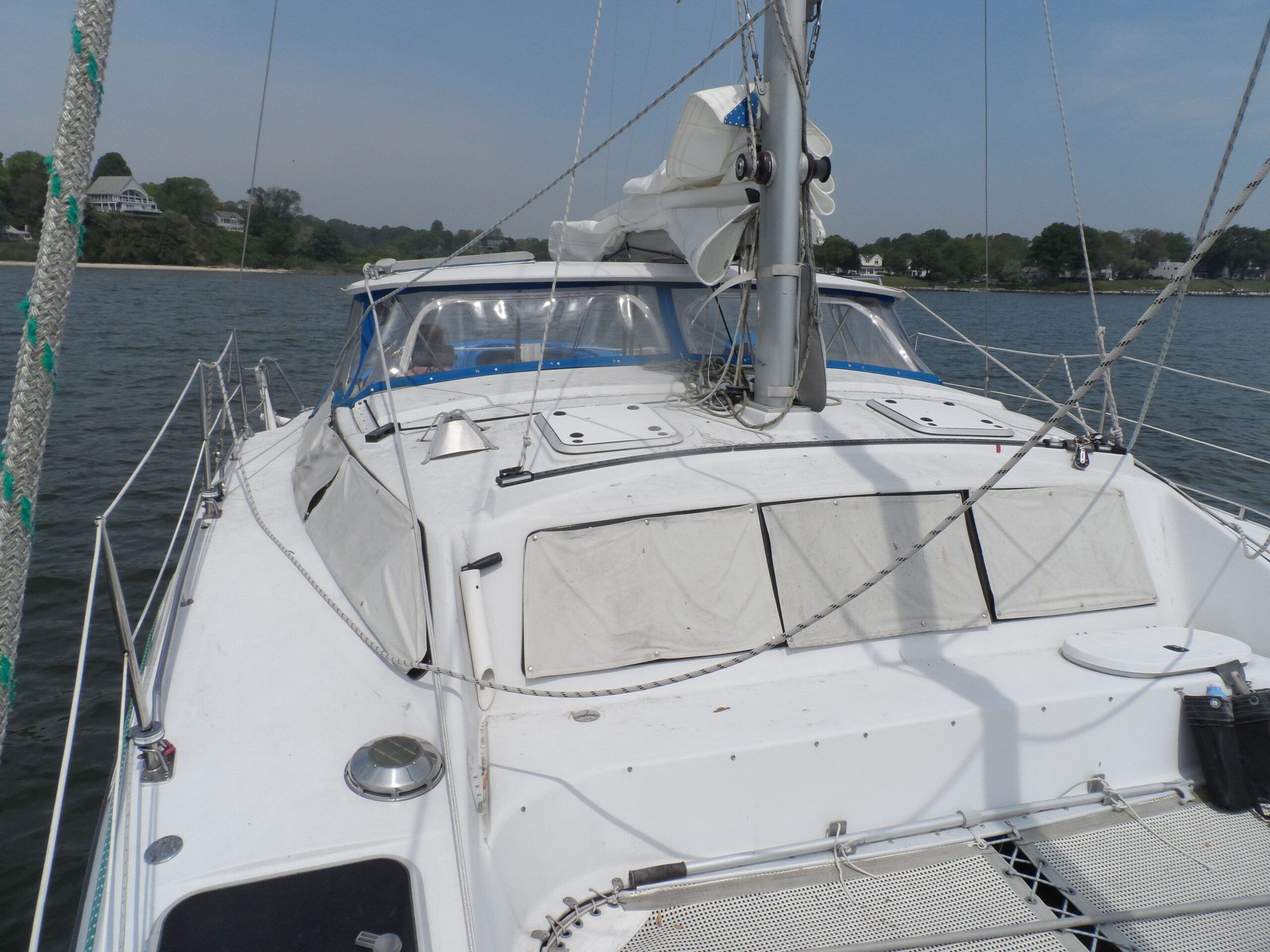
Ample bridgedeck clearance and a good ratio of clearance to beam (the wider the boat, the more clearance she will require to avoid slapping) are vital; with 23 inches of minimum clearance over an 8-foot span, the PDQ 32 is nearly immune to bridgedeck slamming, the curse of catamarans that have accepted low clearance in exchange for increased salon headroom and convenience dockside.
Rigs on cruising catamarans usually look rather stubby, and the standard masthead rig on the PDQ 32 is no exception. With an I dimension (the distance along the front of mast from the highest genoa halyard to the main deck) of 40 feet, 10 inches and a sail area of 443 square feet, the PDQ 32 rig is a bit smaller than rigs on monohulls of similar length and has less sail area. For example: The Beneteau First 325 has an I of 41 feet, 7 inches and a 489-square-foot sail area; the Catalina 320 has an I of 43 feet, 7 inches and a 521-square-foot sail area. Also, the Gemini 105M cat carries 515 square feet of sail. However, the PDQ is by far the lightest of these boats, managing to still do well in light air and really scoot when the breeze hits 15 knots.
A tall rig was a PDQ 32 option, most common on the heavier long-range cruising (LRC) version. However, it has not proven to be faster through a range of wind strengths.
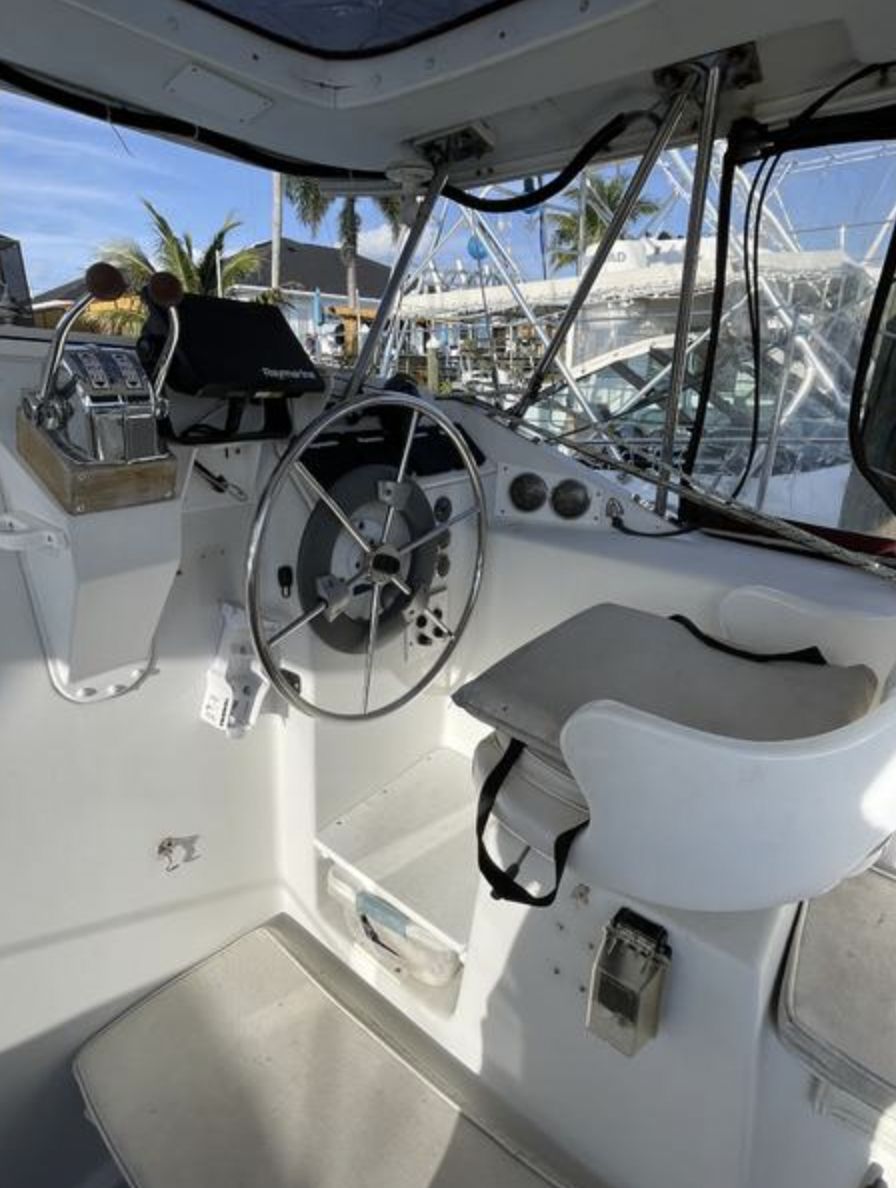
The PDQ 32 has a clever, unique cockpit design that allows three levels of seating—all under a hardtop. To help solve the headroom problem in the saloon, the companionway hatch is very wide and slides forward so that just aft of the dinette table, there is full headroom (6 feet, 11 inches) under the hardtop. When the hatch is closed (a rare occasion in most conditions, if you have vinyl windows connecting the hardtop to the deck), most crew must stoop with only 5 feet, 2 inches of headroom. However, when the slider is open, the saloon becomes a delightfully airy place.
Some owners have rigged mosquito netting from the hardtop to the main bulkhead, allowing for great ventilation, even on steamy nights. While the area is not very large, there’s plenty of seating, good visibility on the top tier, easy access to the deck, and yet a feeling of protection and shelter.
This setup also means that foul-weather gear is seldom used, as the boat is easily sailed from under the hardtop, and the deck stays dry aft of the beam. In winter, sweaters and windbreakers are the rule in all but sub-freezing weather, since wind is effectively blocked from the helm on most points of sail.
There is no exterior brightwork—music to a liveaboard’s ears—and the handrails are stainless steel. The double lifelines, on 24-inch stanchions, have gates at the aft corner and sugar-scoop transoms. Cleats are 10-inch anodized aluminum.
DECK GEAR
Most of the sail-handling equipment is Harken brand: blocks, cam cleats, and travelers for the self-tending jib, mainsheet, and slider. Primary and secondary winches are located on either side of the cockpit, a mix of two-speed, self-tailing Harken 32s and Lewmar 40s. Rope clutches are Spinlock Easylocks. Some boat owners lead lines back to the cockpit, while others have twin, two-speed winches mounted on the mast.
The PDQ 32’s steering is by Whitlock. There is also a very workable emergency tiller, and jammed rudders are easily isolated thanks to access through a stern locker. Seacocks are Marelon by Forespar.
Factory ground tackle was most often a 25-pound Delta or Bruce anchor, backed with 50 feet of quarter-inch G4 chain and 150 feet of half-inch, nylon three-strand line led to a windlass and a bow chain locker. Cruising owners have generally upgraded to a 35-pound Rocna or Manson Supreme anchor and 100 feet of quarter-inch G4 chain, again backed with line.
Since these boats typically anchor in shallow water, this allows anchoring on all-chain about 90 percent of the time. A bridle constructed from half-inch line is typically used to secure the anchor rode, as the anchor rollers are mounted on the bows and the crossbeam is not designed for anchoring loads. Windlasses vary, but are most commonly vertical Lewmar Sprints with a combination rope/chain gypsy.
SYSTEMS
Tankage consists of a 30-gallon aluminum or polyethylene fuel tank aft of the cockpit, a 44-gallon polyethylene water tank under a shelf forward of the dinette, and a 30-gallon fiberglass holding tank that can be emptied offshore by means of a Y-valve and hand pump. The fiberglass holding tanks on our test boat have proven permeation-free after 18 years.
The gasoline tank is located in a sealed, bottom-vented bridgedeck compartment that can serve double-duty as safe storage for portable gas cans and propane cylinders.
The propane system is engineered to current standards, with a forward vented locker sized for two 12-pound tanks. Leak detection in both hulls is tied to a controller and a locker-mounted solenoid valve. Some of these boats have as many as four propane appliances fed from the locker-stove, refrigerator, water heater, space heater-each with a separate propane line.
PDQ thoughtfully located all through-hull fittings and head-related plumbing (except for about 10 inches of waste and intake hose) in a ventilated bulkhead compartment. If the hoses do permeate-as they did on the test boat (see PS April 2012 online)-the odor is isolated from the cabin. However, the holding tank vent is located in an unfortunate position, upwind of salon hatches, but this is easily managed with either proper holding tank treatments or a vent filter.
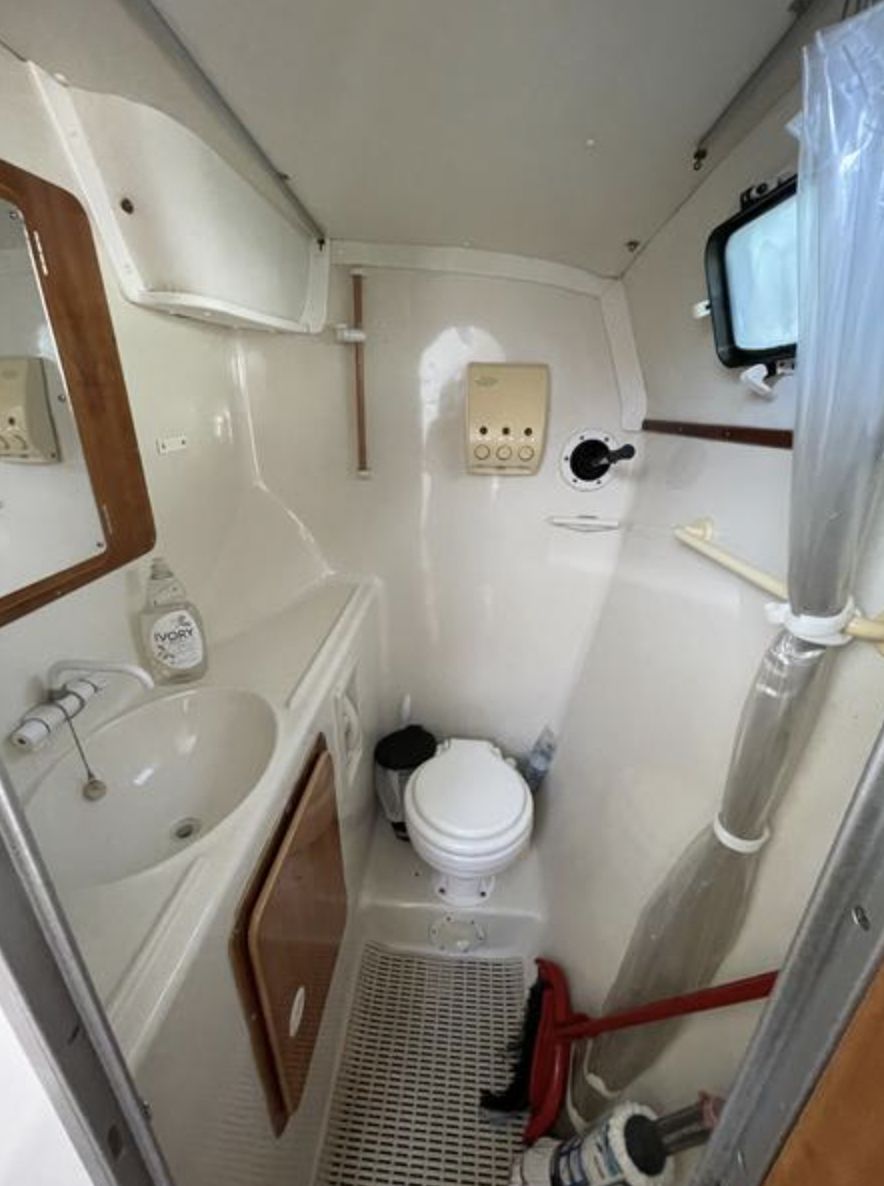
The contained through-hull’s location proved its worth when the test boat was delivered shortly after its current owner purchased it. After sea trials, the speed transducer was removed and replaced with a plug; in the process, the O-ring was positioned improperly. Some hours into the two-day trip up the Chesapeake in December (think actual freezing water), the crew noticed a little water dripping past one of the head hoses. Investigation revealed that the forward through-hull compartment had flooded 2 feet deep. The crew pumped it out and realized it was still leaking, but rather than struggle with freezing plumbing in what had become gale conditions, they sailed the boat with the leak for two more days, because the flooding was so well contained. The boat has crash tanks fore and aft (the rudder post is in the latter), a glassed-in holding tank on starboard, and another sealed bulkhead before the cabins begin on each side.
The electrical panel, located in the starboard hull, contains numerous spare breakers; we’ve not heard of any owner running out. Wiring is well organized and labeled. An inverter with automated transfer switching feeds a 110-volt system sufficient for heating and air-conditioning loads; however, a generator is not standard, so you must be plugged in to shore power or invest in a generator in order to use them.
Batteries include three group 27, deep-cycle wet cells (or an equivalent bank) located in lockers surrounding the cockpit, which makes watering and replacing them easy. Most owners have added solar panels to the hardtop, and some have additional panels above the davits; 170 to 400 watts is typical.
PROPULSION
The classic PDQ 32 is powered by twin, high-thrust Yamaha 9.9-horsepower outboards mounted in cockpit wells. This central location, 12 feet forward of the transom, places the engines near the boats center of gyration, virtually eliminating cavitation in all conditions and offering the ability to push into 30-knot headwinds.
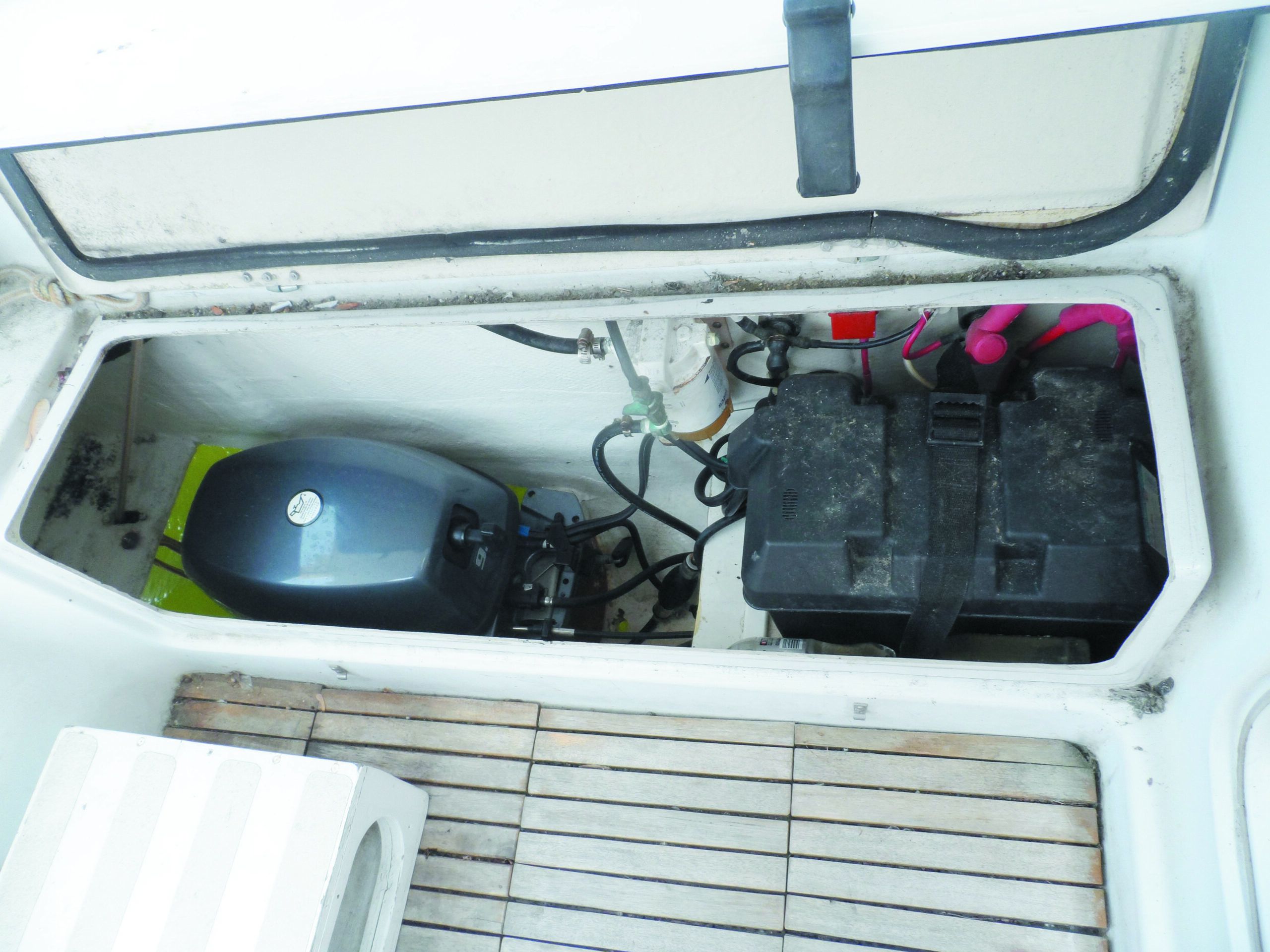
The LRC version of the 32 has twin, inboard 20-horsepower Yanmar diesels mounted under the aft-cabin bunks. (About 20 percent of PDQ owners opt for the twin diesels.) The diesels offer less noise than outboards and add just a little more speed under power (7.4 knots versus 7.2 knots for the classic), but they reduce speed under sail slightly (about 1 knot), due to increased weight and prop drag. The diesel-LRC version gains a little storage in the cockpit (the outboard wells) but forfeits the cavernous space under the bunks for a net loss in storage.
Whether this storage loss and the weight gain is a fair trade for better propulsion and more reliability depends on whether you sail or motor most of the time, so opinions vary. With twin screws, either version will spin in its own length, and backing into a slip is common practice as boarding the boats is easiest from the stern quarter. However, the twin outboards can be retracted, significantly enhancing performance. Plus, they’re less expensive and can be taken to a shop for service.
Owners of the classic PDQ 32 compensate for lost battery charging power by adding solar panels and a small generator. A rare few add wind generators, but it is pretty common to see a Honda generator on a PDQ 32. Those who have opted for the new, high-thrust 9.9-horsepower Yamaha outboard conversions can expect a charging capacity of 6 amps at 12 volts each. This, with solar supplementing, is more than sufficient for a cruising couple.
INTERIOR
Headroom is 5 feet, 2 inches in the saloon with the slider closed), 7 feet, 2 inches in the amas, and 6 feet, 5 inches in the aft cabins. In warm weather, the salon bunks become premium, comfortable in dimension and bathed in breeze from well-positioned fans and overhead hatches. Aft cabins get stuffy owing to their location aft of the cockpit, but hatches provide airflow on even the steamiest night.

While there’s a good deal of white fiberglass showing, the overhead liner is vinyl. The cabin sole is teak and holly. Plywood is used for under seats and bunk access boards. The sleeping cabins are primarily carpeted and have cherry and ash trim. Each has a small hanging locker and several enclosed cabinets for stowage.
There are two private staterooms, complete with six opening ports, numerous cabinets, and cavernous storage areas under the bunk (on the LRC models, this is an easy-to-access engine bay). The mattresses take standard queen bedding. The salon table converts into either a king berth or two twins; there are several versions. We recommend adding quality mattress toppers to the bunks.
With so much interior volume-and no factory air-conditioning (or heat)-good ventilation is a must, and the PDQ does not fall short. Two Bomar hatches above the amas ventilate the forward compartments, and two over the dinette provide salon ventilation; there are four smaller hatches aft, and three in the cockpit. Smaller Bomar side windows line the flanks (13) for a total of 24 opening hatches and ports.
There also are four solar vents in the forward compartments and cabins. Additional light pours in through the smoked acrylic windows surrounding the saloon, providing a rare 270-degree forward panorama, sufficient for watch-keeping during a quick meal.
Galley appliances include a Plastimo propane stovetop, a microwave, and a refrigerator (either a Dometic propane fridge or a top-opening icebox with a cold plate). Because catamarans do not heel much, the propane fridge actually works well, even if it’s less efficient than an icebox.
While galley counterspace and stowage is limited (there is a large cabinet under the propane fridge, and the bilge in the adjacent cabin is easily accessed), PDQ has worked in a few clever aids such as a pullout spice rack, hinged cutting board, and many shallow cabinets. It’s best to keep the gelcoated countertops covered to prevent wear.
PERFORMANCE
The PDQ 32 is basically a 7- to 10-knot boat. We’ve seen 14 knots in non-surfing conditions, using either a spinnaker or genoa, but we don’t recommend it. Although we have long experience with performance cats and know their habits, we only push for short periods and with full attention. We prefer to back off just a little, staying comfortably within the boats performance envelope and enjoying the day.
As a good rule, reefing begins at about 9 knots of boat speed or 20 knots of apparent wind to windward, starting with the main. The LRC model is about a knot slower. Upwind in sustained 15 knots true, expect about 6 to 7 knots with the jib and 8 knots under genoa. Beam reaching in the same winds, we’ve made 7 to 8 knots and 9 to 10 knots, respectively.
Most PDQ 32 owners buy 90-percent asymmetrical spinnakers for off-the-wind sailing. The tack is controlled with a 2:1 purchase tack line led to each bow cleat, allowing the tack to be moved from side to side to optimize set; it is generally centered through jibes. With a sleeve, setting and dousing the spinnaker is fail-safe, and the sleeve provides sufficient protection while the sail is stored in a bow locker, eliminating the need for a separate sail bag.
It is not hard to see double-digit speeds on the PDQ, but caution is warranted. In a breeze downwind, there is hidden power, and the tack should be kept to windward and the sheet well eased. The spinnaker is best considered a light- to moderate-wind sail, and returned to its bag in favor of the genoa when the true wind is over 15 knots. In a breeze, wing-and-wing dead downwind makes for solid velocity made good and glass-smooth sailing—what cruising in these boats should be about.
In any case, you’ll pass cruising monohulls up to 45 feet when reaching in a breeze, and pace 40-footers under most conditions. To windward, you’ll tack through a wider angle, but you’ll stay with considerably larger boats when the breeze is up. The PDQ 32’s PHRF ratings range from 135 to 234, depending on equipment and location.
The PDQ 32 has a deeper draft than its big sister, the PDQ 36—3 feet, 2 inches compared to 2 feet, 10 inches—improving windward performance by a few degrees. Tacking though 100 degrees over ground is possible, if the boat is sailed well and kept moving. The profile view reveals that the keels are unusually far forward; perfect for drying out, but all wrong for tacking.
The keel’s center of lateral resistance (CLR) is too far forward, relative to the sail’s center of effort (COE), causing the boat to snap into irons and stay there if given a chance. Back-winding the jib to force the bow through the eye of the wind is a sloppy solution; the boat nearly stops, control is lost, and it may pop back into irons. Backing her to one side, wearing ship, is not reliable either.
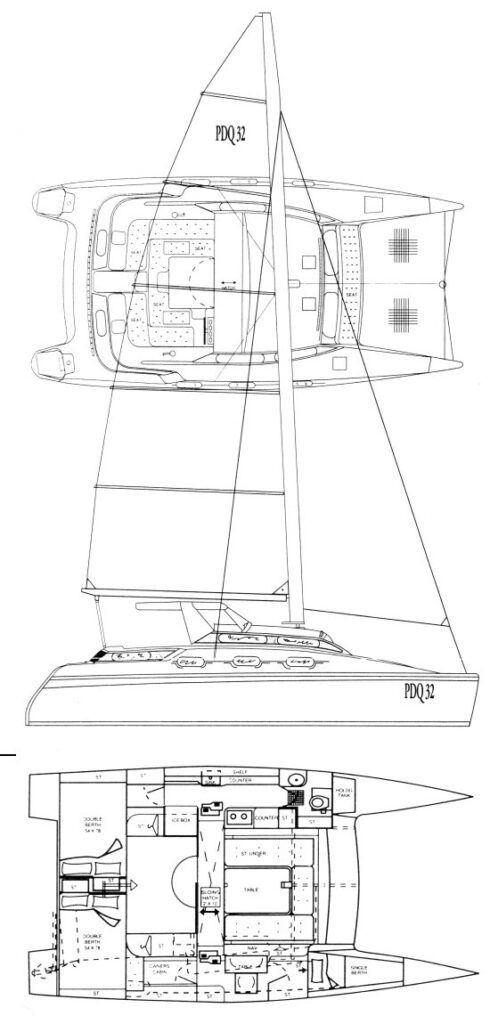
| PDQ 32 | Courtesy: Sailboatdata.com |
|---|---|
| Hull Type: | Catamaran Twin Keel |
| Rigging Type: | Masthead Sloop |
| LOA: | 31.58 ft / 9.63 m |
| LWL: | 31.00 ft / 9.45 m |
| S.A. (reported): | 498.00 ft² / 46.27 m² |
| Beam: | 16.00 ft / 4.88 m |
| Displacement: | 7,200.00 lb / 3,266 kg |
| Max Draft: | 2.50 ft / 0.76 m |
| Construction: | FG w/vacuum bagged corecell core |
| First Built: | 1995 |
| Builder: | PDQ Yachts Inc. (CAN) |
| Type: | Outboard |
| Fuel: | 27 gals / 102 L |
| Water: | 47 gals / 178 L |
| S.A. / Displ.: | 21.44 |
| Disp: / Len: | 107.89 |
| S#: | 4.78 |
| KSP: | 0.73 |
| BN: | 1.16 |
| I: | 40.33 ft / 12.29 m |
| J: | 12.75 ft / 3.89 m |
| P: | 35.00 ft / 10.67 m |
| E: | 13.75 ft / 4.19 m |
| S.A. Fore: | 257.10 ft² / 23.89 m² |
| S.A. Main: | 240.63 ft² / 22.36 m² |
| S.A. Total: | 497.73 ft² / 46.24 m² |
| S.A./Displ. (calc.): | 21.43 |
| Est. Forestay Length: | 42.30 ft / 12.89 m |
| Mast Height from DWL: | 45.00 ft / 13.72 m |
| Designers: | Steve Killing |
| Builders: | PDQ Yachts (CAN) |
The savvy PDQ owner has a different tacking procedure: Accelerate to maximum windward speed by cracking off a few degrees, throw the wheel nearly hard over, release the jib the moment it luffs, and dump the main traveler all the way to leeward when the main breaks (the traveler cleats separately on each tack, allowing you to pre-set the traveler on the new tack down). Steer well beyond the normal 100-degree tack, placing the true wind on the beam, haul and grind the jib in as soon as it can fill to keep the bow off, and then steer back up to proper course, hauling the traveler up as the boat accelerates. The process is simple and quick, once dialed in.
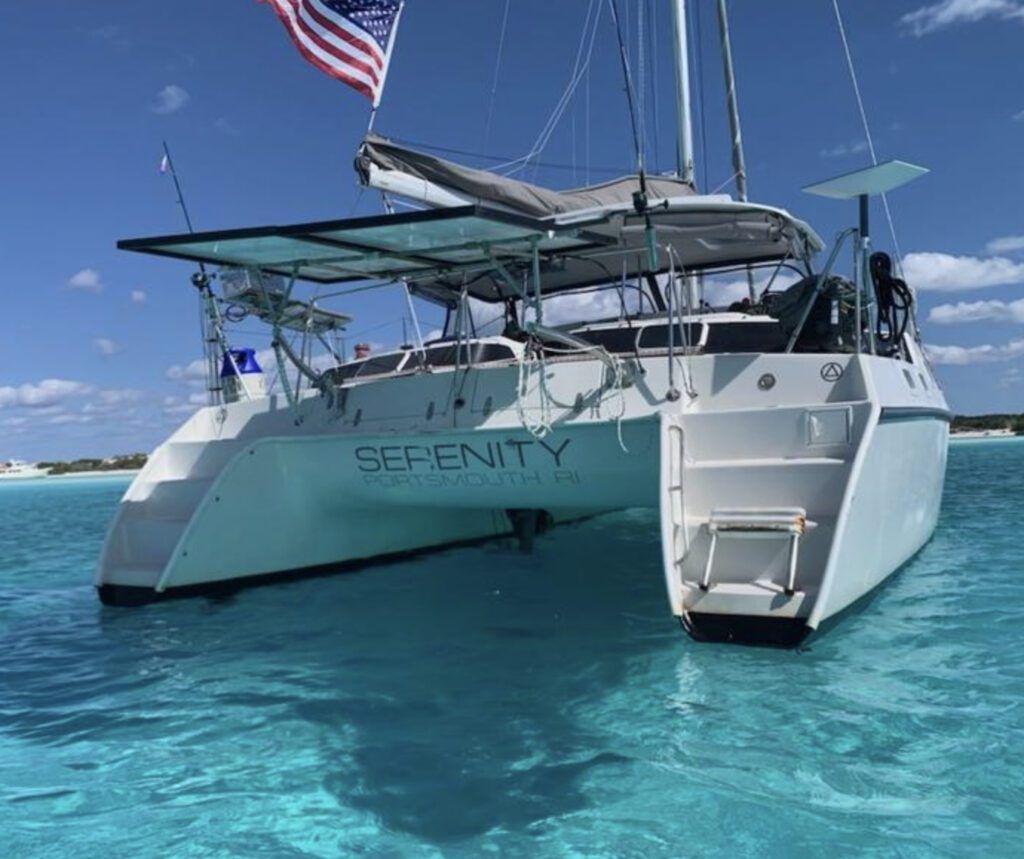
There are currently three PDQ 32s listed for sail on the website Sailboatlistings.com as of this writing on September 18, 2024. They are each mid-90s vintage and priced between $80,000 and $90,000. We’re featuring one of them here. Serenity is owned by Practical Sailor contributor Alex Jasper, who reports a change in course means she’s reluctantly putting her PDQ on the market.
For Alex, Serenity checked all the boxes for an ICW boat with Bahamas aspirations. “We had friends with an Amel whose first boat was a PDQ 32, and while we were sailing the Amel they kept missing their 32,” says Alex. “That’s when we started considering a PDQ 32. Later, we decided the PDQ 32 was the right boat for us because of both price and size.”
Alex owns the tall-mast Altair version of the 32, which was built in 1998 at PDQ’s Whitby, Ontario yard. She is delighted with the mid-90s version of this Slater/Killing design, which shows a maturity in the build quality that has never let her down. “Sailors with older boats, like mine, frequently complain about hatch leaks,” Alex says. “We never had a hatch leak unless we failed to close the hatch properly. She has aged beautifully.”
Serenity’s highlights: Alex likes the bench seat on the forward edge of the coach roof just aft of the trampoline—a perfect spot for a sundowner or to sail in calm conditions.
Underway she appreciates the PDQ’s center cockpit, which can be enclosed with a hard-top bimini and canvas side screens. Sail control lines lead aft from the deck-stepped mast and there’s no reason to go forward underway, particularly helpful when she deploys either one of the boat’s two single-line mainsail reefing systems.
Traffic management through the boat comes down to a single lane, but there’s plenty of space for conviviality around the big U-shaped settee (with 5-foot, 2-inch headroom with the coach roof sliding hatch closed; well over 6 feet with it open). “You get full standing headroom when the cabin ceiling opens up. It gives you a light, airy feeling,” Alex says.
Alex is delighted with the full-size beds in the boat’s two, separate after staterooms. “The designers maximized every bit of space and it’s the most comfortable boat bed I’ve ever slept on.”
She is not thrilled with the carpet material on the interior walls, which she says is scratchy and becomes a mold catcher. She removed it in one of her staterooms and replaced with an easier-to-maintain vinyl.
Lastly, Alex delights in her boat’s safe handling: “She gives a beautiful ‘hove-to,” says Alex, extolling Serenity’s knack for hunkering down if her skipper needs to stop underway. “She’s the kind of boat that really knows how to take care of you.”
Because the CLR is in front of the COE, keep the traveler a few inches below centerline in lumpy conditions, centered when powered up on flat water. Never place the traveler over center, and always ease the mainsheet enough to preserve twist. Reef the main first; this also helps move the COE forward.
Some owners have added genoas to supplement the stock self-tacking jib. This is a real turbo-charge for the PDQ 32 all around the course, as the keels are large enough to support the additional loading and the genoa brings the COE better in line with the CLR, greatly improving balance.
Because the boat is catamaran rigged (no backstay, shrouds to the extreme beam), the genoa is generally rigged outside the shrouds and sheeted to the extreme beam. The resulting sheeting angle (24 degrees) is too wide for efficient windward work. A successful solution has been to add an inner track and a second set of sheets. The genoa is then sheeted tight against the hardtop, reducing the sheeting angle to 15 degrees and giving a good angle of attack without overpressing the low-aspect keels. The boat can’t point as high as a good monohull, but it can really stomp at 50 degrees true. When reaching, the outer tracks provide beautiful sail shape. If you’re a performance-oriented sailor considering a PDQ 32, look for a boat with a genoa and inside tracks. The difference is real.
CONCLUSION
Compared to other cats in the same class, the PDQ 32 is as fast in base form, and even faster when tweaked, something the strong but light design seems to encourage. Quality construction has proven to be a boon to owners as well. Sails and moving parts require replacement and upgrade, but the structure and basic systems have been bulletproof.
The center-cockpit setup is different, but testers like the privacy of queen cabins and the expansive forward view, something missing in most cats this size. The salon slider is a unique feature that allows incredible openness in warm weather, requires some stooping in cold weather, and is the cost of high bridgedeck clearance and superior helm visibility. All compromises. Among the few cruising cats of this size, the PDQ 32 offers excellent value.
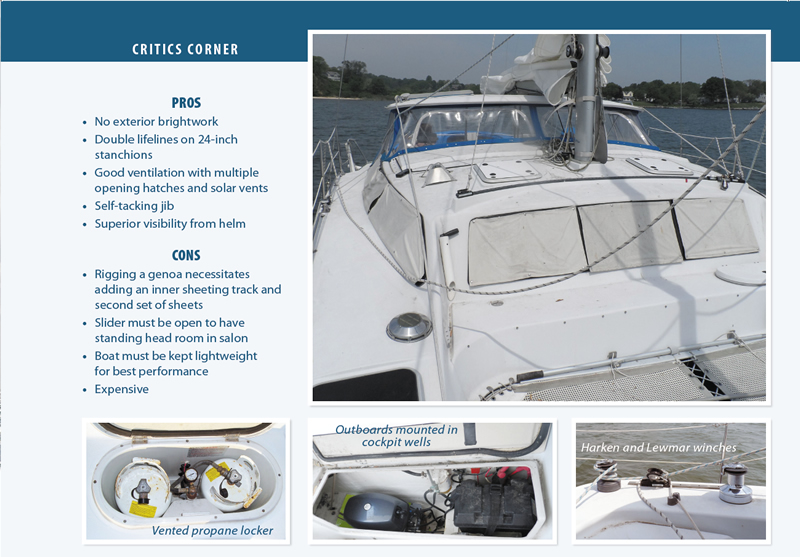
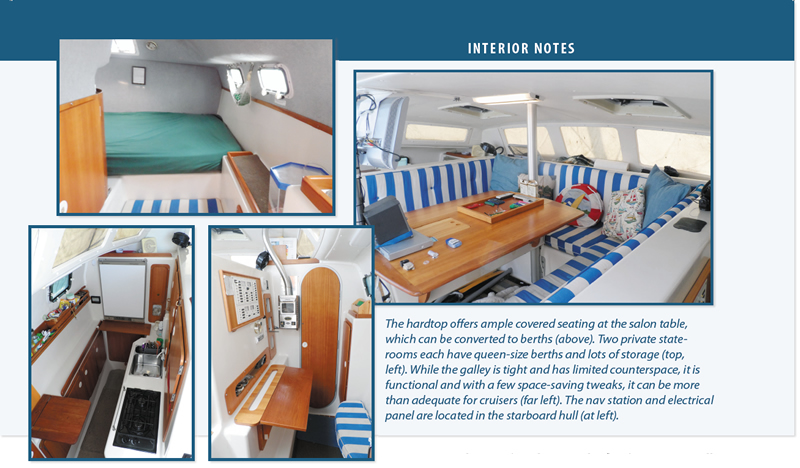
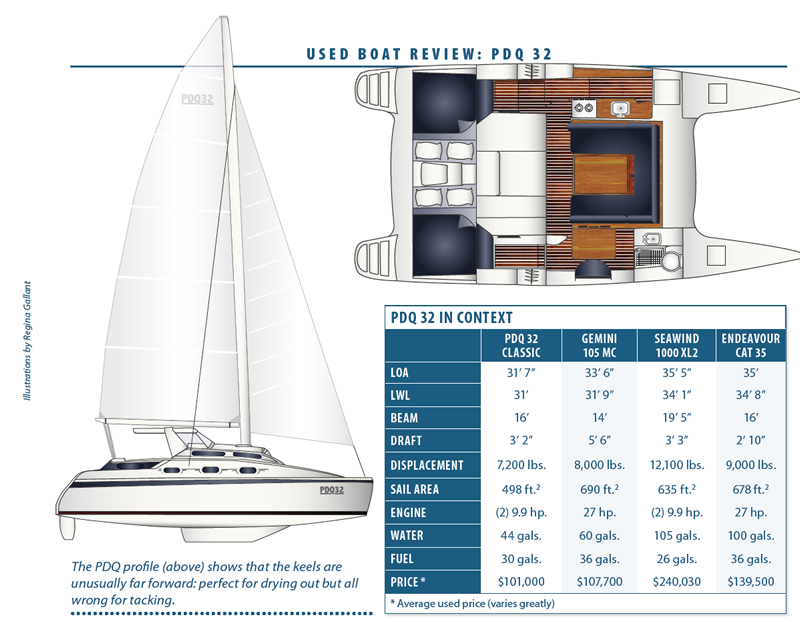
This article was first published December 16, 2015 and has been updated





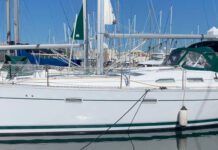







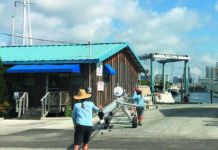




















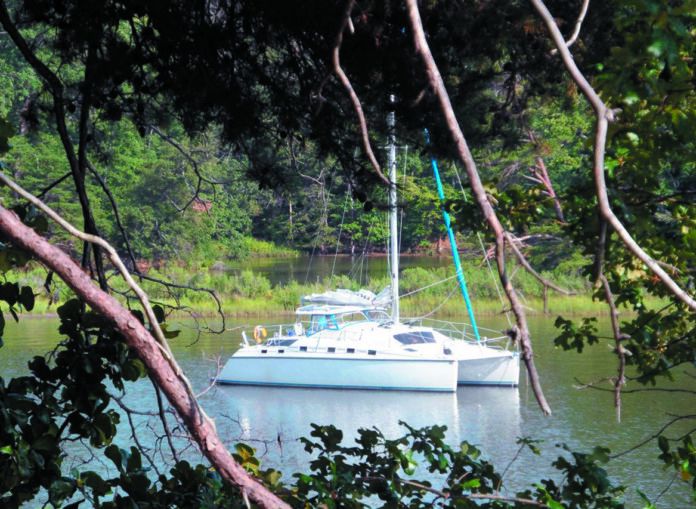




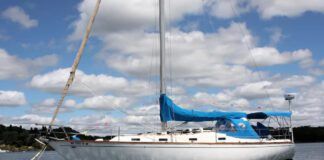
Best, detailed, comprehensive review that I can recall reading. Thank you so much!!!
Can you explain why you feel this is an “in- or near shore” boat rather than one that could venture further afield? I seem to hear the Seawind 1100 and even some Geminis described as blue water capable, and they don’t appear to be that different. But the close to shore description of the PDQ 32 crops up several places, so I’m assuming there’s a reason. Thanks.
I don’t believe “close to shore” is a fair description of the PDQ 32. The couple mentioned in the article who switched to an Amel after sailing a PDQ32 would be Mike and Rebecca Sweeney who published the Zero to Cruising blog. They sailed their PDQ32 from Ontario to Florida, the Bahamas and on to the Eastern Caribbean. There were plenty of “blue water” passages in their journey. We have sailed our PDQ 32 LRC up and down the west coast of Florida, the Keys, Dry Tortugas and the Bahamas. No, we didn’t cross an ocean if that is your definition of blue water, but I know of some 32s that have sailed to Australia.
There are some other advantages of the Long Range Cruiser model not mentioned in the review. The twin Yanmar 2GM20F engines can easily run high output alternators for serious charging capacity. For example, my PDQ 32 LRC has 420 AH of lithium batteries that can be rapidly charged with continuous 80A from a Balmar alternator on one engine. This alternator can also power a 30GPH DC watermaker while motoring. The PDQ32 LRC models also have shaft drives, not sail drives found on the 36 LRC models. Another nice feature of the LRC models not usually mentioned is the presence of a robust skeg in front of each rudder for protection. Finally, I believe the statement that the LRC is 1 knot slower assumes prop drag. This is mitigated by adding feathering props.